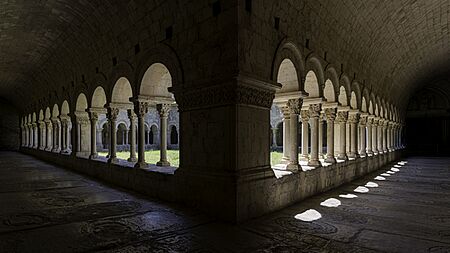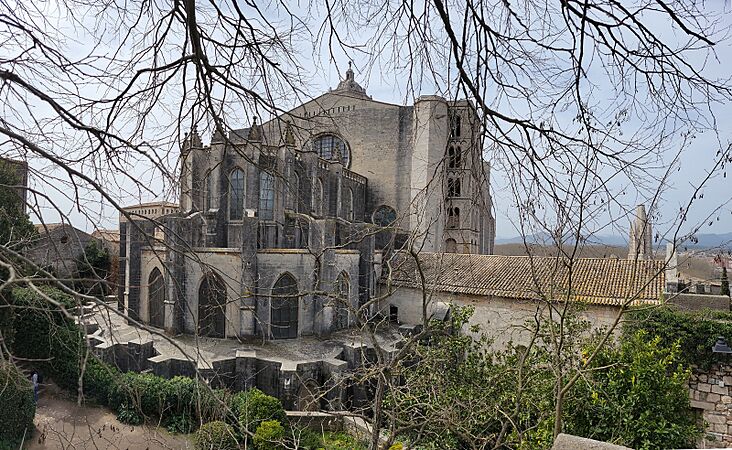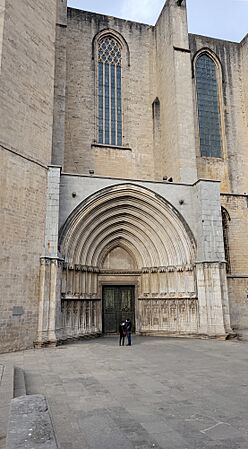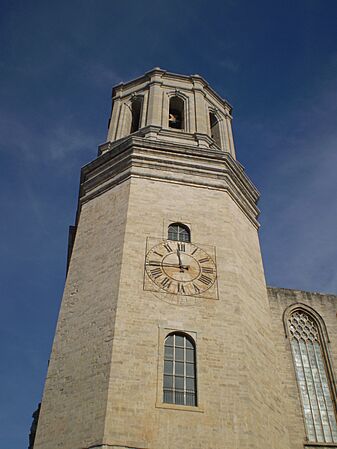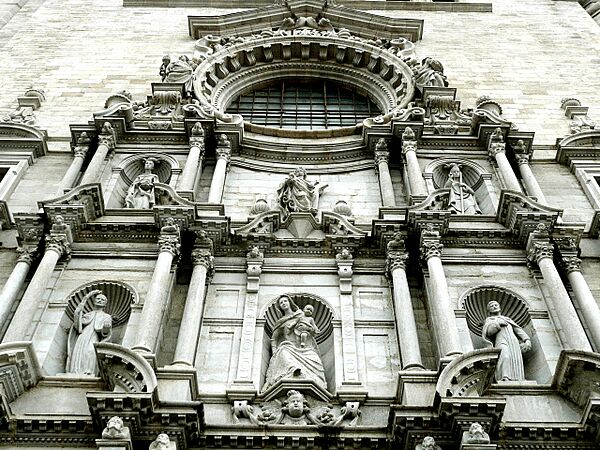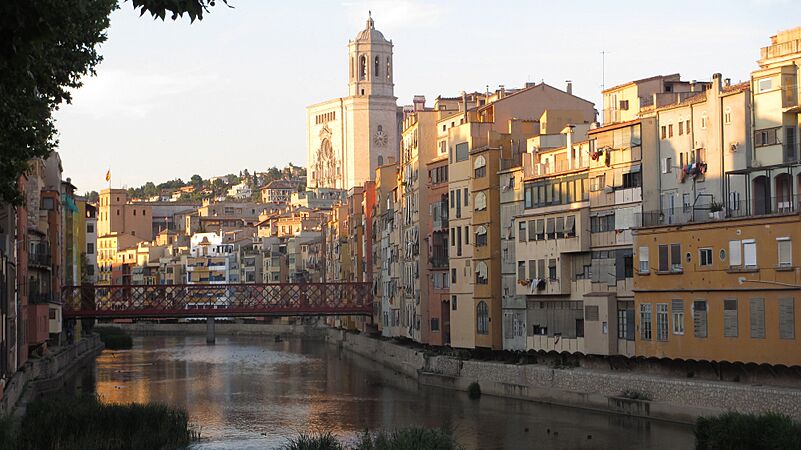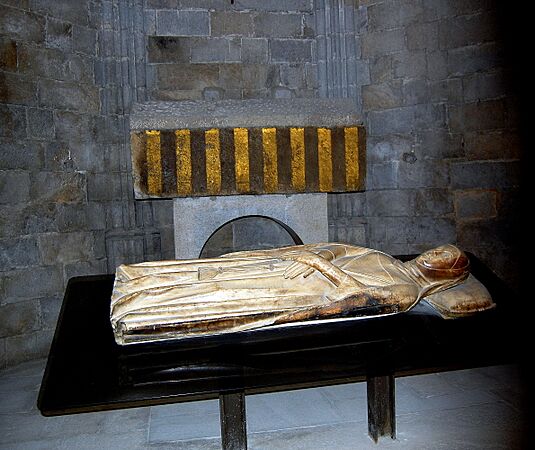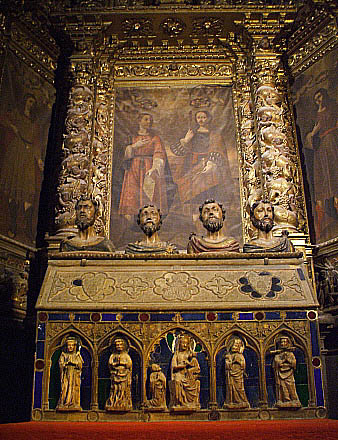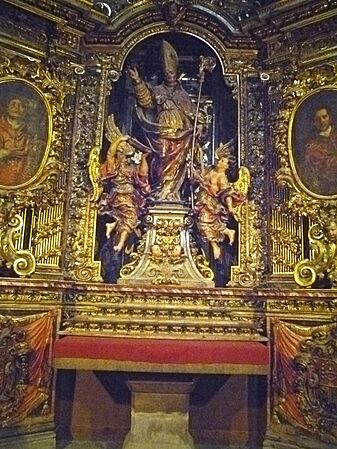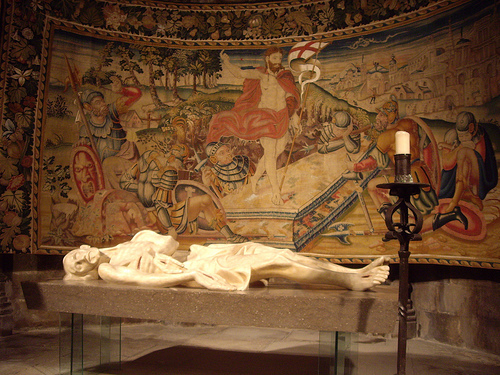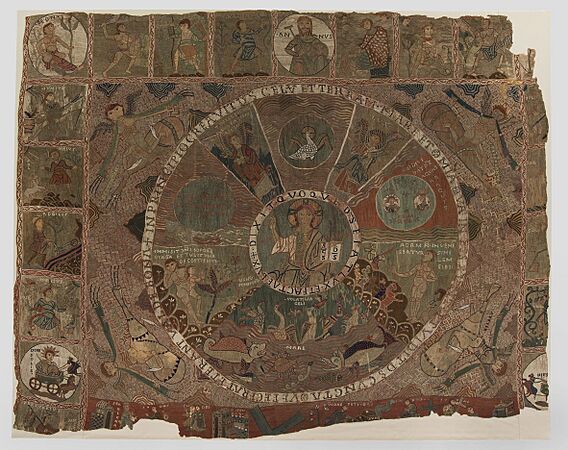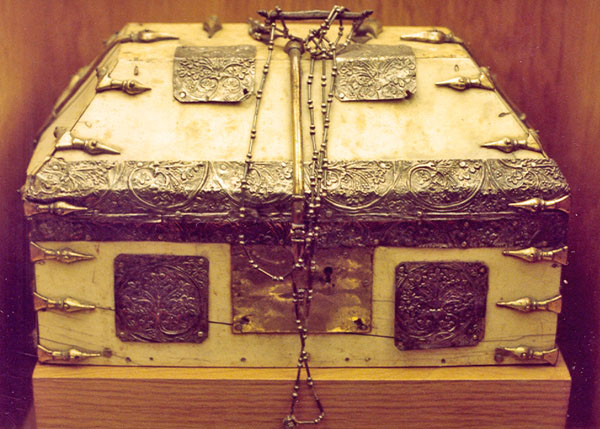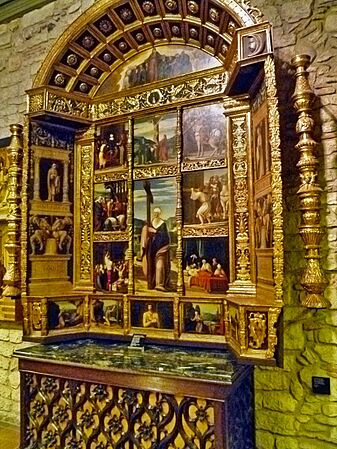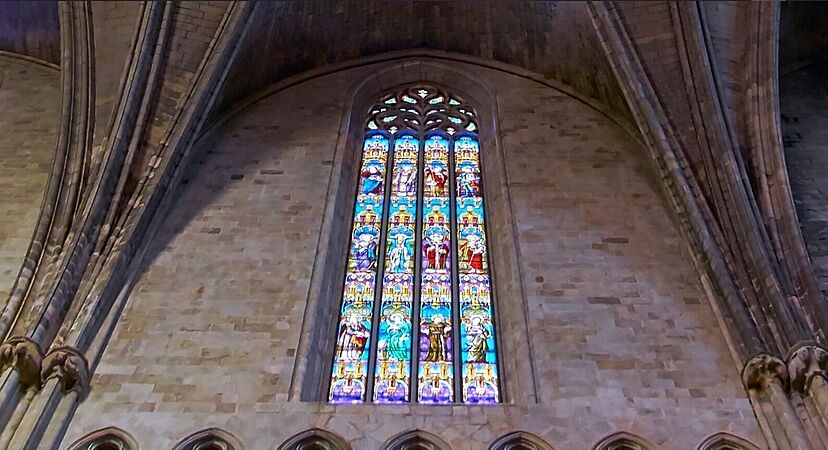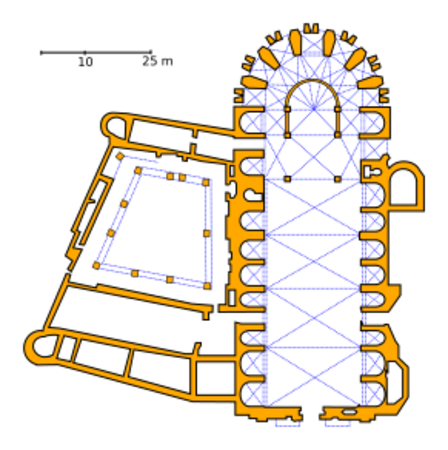Girona Cathedral facts for kids
Quick facts for kids Girona Cathedral |
|
|---|---|
| Cathedral of Saint Mary | |
| Catedral de Santa Maria | |

West façade and the grand Baroque staircase
|
|
| 41°59′15″N 2°49′35″E / 41.98750°N 2.82639°E | |
| Location | Girona, Catalonia |
| Country | Spain |
| Denomination | Catholic |
| History | |
| Status | Cathedral |
| Dedication | Mary, mother of Jesus |
| Dedicated | 21 September 1038 |
| Architecture | |
| Style | Romanesque, Gothic, Baroque |
| Groundbreaking | 1015 |
| Completed | 18th century |
| Specifications | |
| Length | 85 m (278 ft 10 in) |
| Nave width | 23 m (75 ft 6 in) |
| Height | 45 m (147 ft 8 in) |
| Administration | |
| Metropolis | Tarragona |
| Diocese | Girona |
The Cathedral of Saint Mary (in Catalan, Catedral de Santa Maria) is a large Catholic church in Girona, Spain. It is the main church for the Roman Catholic Diocese of Girona.
This amazing building has the widest Gothic nave (the main part of the church) in the world. It is about 23 meters (75 feet) wide! Building started in the 11th century in the Romanesque style. Later, in the 13th century, builders switched to the Gothic style. Today, only the 12th-century cloister (a covered walkway) and one bell tower remain from the original Romanesque church.
Contents
History of Girona Cathedral
A Christian church stood here long ago. In 717, after the Muslims took over Spain, it became a mosque (a Muslim place of worship). Later, in 785, the Franks (a group from what is now France) took the city back. The church was then used as a Christian church again in 908.
Building the Romanesque Cathedral
By 1015, the church was in bad shape. Bishop Peter Roger, a local leader, used money from selling another church to fix it. The church and its cloister were built in the Romanesque style until 1064. The bell tower was finished in 1117.
Building the Gothic Cathedral
In 1312, the church was redesigned by Pere Sacoma. After some time, Guillem Bofill and Antoni Canet began the new project in 1416. They decided to build a huge Gothic nave. This new nave became the widest Gothic nave in the world, at almost 23 meters (75 feet). It is even wider than the naves of famous churches like Reims Cathedral and Notre Dame de Paris. The ceiling of the nave is about 35 meters (115 feet) high.
Outside the Cathedral
The front of the church, called the façade, is in the Baroque style. It was started in 1606, but the top part was not finished until 1961. A grand staircase, completed in 1607, leads up to the main entrance. Sculptures on the façade were added by local artists in the 1960s.
Other interesting parts outside include the Gothic portal (doorway) of St. Michael on the north side. There is also the southern portico (covered entrance) of the Apostles, built in the 14th century. This portico once had sculptures of the Twelve Apostles. Most of these are now lost, but two, showing St. Peter and St. Paul, are in the church's chapter house.
The cathedral has two bell towers. The older one is called the Charlemagne Tower. It was one of two towers that stood next to the first Romanesque church. This tower, started in the early 11th century, is square and has six levels. Each level has double windows.
Inside the Cathedral
The inside of the cathedral has one very wide nave with high, arched ceilings. These ceilings are supported by strong Gothic buttresses (supports on the outside walls). The side walls have a triforium (a gallery above the arches) with beautiful stained glass windows.
The apse (the rounded end of the church) is separated from the nave by a tall wall. This wall has a huge pointed arch in the middle, which frames the main altar. Two smaller arches on either side lead to the ambulatory (a walkway around the apse). High up on the wall, there is a large rose window (a round stained glass window) from 1705, dedicated to St. Michael. Two smaller rose windows are on either side.
The main altar, made of white marble, dates back to the 11th century. Other art inside includes the Gothic tomb of Berenguer d'Anglesola (who died in 1418). This tomb was made by Pere Oller.
Romanesque Cloister
The 12th-century Romanesque cloister is very special. It has many columns with carved tops, called capitals. These carvings show amazing figures, animals, and plants. The frieze (a decorated band) above the columns shows scenes from the New Testament.
One of the artists who worked on the cloister was Arnau Cadell. Also in the cloister is the Chapel of Our Lady of Gràcia i de Bell-Ull. This chapel was once a gate to the cloister and was updated in the Gothic period. Its tympanum (the space above a doorway) has an image of the Virgin Mary from the 13th century. Many tombs of important people from the 14th to 18th centuries are also found in the cloister's walkways.
Cathedral Treasury and Museum
The museum inside the cathedral holds many valuable items. Its most famous piece is the Tapestry of Creation. This tapestry is from the 11th or early 12th century and is considered a masterpiece of Romanesque weaving.
Other important artworks include:
- The Gerona Beatus, a beautifully decorated book from the 10th century.
- A special box from the 10th century, which was a gift to Caliph al-Hakam II's son.
- A sculpture of "Charlemagne" by Jaume Cascalls (1345), though it is now thought to be King Peter IV of Aragon.
- A 15th-century Gothic Pietà (a scene of Mary holding Jesus after his crucifixion) by Jaume Cabrera.
- A 16th-century Renaissance Retable (an altarpiece) of St. Mary Magdalene by Pere Mates.
- The Cross of the Pearls, a silver cross from the 16th century with colorful enamel.
The museum also has many other paintings and items from the Medieval to Baroque periods. These include processional crosses and special containers for holy relics.
Filming Location
The Girona Cathedral and its steps were used as a filming location for the popular TV show Game of Thrones. In season 6, the cathedral stood in for the Great Sept, a large house of worship. Special effects were used to change parts of the building and steps in two episodes: "Blood of My Blood" and "The Winds of Winter".
Gallery
-
View of the cathedral, with the Eiffel Bridge over the Onyar in front
-
Sculpture of Countess Ermessenda of Carcassonne, by Guillem Morell (around 1385)
-
Sarcophagus of Count Ramon Berenguer II, by Guillem Morell (around 1385)
-
Tapestry of Creation, located in the Cathedral Museum
See also
 In Spanish: Catedral de Santa María (Gerona) para niños
In Spanish: Catedral de Santa María (Gerona) para niños




